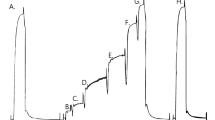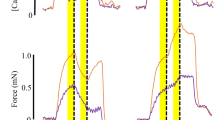Summary
To understand how the coexistence of fast and slow contractile and regulatory systems within single skeletal muscle fibres might affect contractile behaviour, fibre segments from the fast-twitch extensor digitorum longus and predominantly slow-twitch soleus muscle of the adult rat were tied together, either in parallel or in series, and then activated in Ca2+-and Sr2+-buffered solutions. Experimental force-pCa and force-pSr relations were compared with theoretical force-pCa and force_pSr curves predicted by a model for composite fibres, which accounted for the coexistence of fast and slow myosin within the contractile unit and enabled an estimate to be made of the relative contribution of fast- and slow-twitch elements within the tied-fibre combinations. The contractile behaviour of a fast-twitch and a slow-twitch muscle fibre tied either in series or in parallel, were compared with the force-pCa and force-pSr data predicted from the composite fibre model. Interestingly, the resultant force-pCa(-pSr) curves of the parallel-tied fibre combinations were well fitted with those predicted by the composite model. However, the experimental force-pCa(-pSr) curves of the series-tied fibres were not well fitted by a composite curve based on the known proportion of fast- and slow-twitch fibre components. A total force-length diagram was devised to take into account changes in the length of the fibre segments tied in series during activation, as well as possible differences in fibre diameter. Using this diagram it was possible to explain accurately the Ca2+ and Sr2+ activation curves of known fast- and slow-twitch segments tied in series. The results from this study are important for the interpretation of contractile date obtained from single muscle fibres exhibiting mixed fast- and slow-twitch contractile characteristics. Such muscle fibres have previously been identified in animals affected by muscular diseases (e.g. dystrophy), in mammalian extraocular muscles and in animals subjected to long-term exercise training.
Similar content being viewed by others
References
ARIANO, M. A., ARMSTRONG, R. B. & EDGERTON, V. R. (1973) Hindlimb muscle fiber populations of five mammals. J. Histochem. Cytochem. 21, 783–94.
ARMSTRONG, R. B. & PHELPS, R. O. (1984) Muscle fiber type composition of the rat hindlimb. Amer. J. Anat. 171, 259–72.
BAUMANN, H., JÄGGI, M., SOLAND, F., HOWALD, H. & SCHAUB, M. C. (1987) Exercise training induces transitions of myosin isoform subunits within histochemically typed human muscle fibres. Pflügers Arch. 409, 349–60.
BILLETER, R., HEIZMANN, C. W., HOWALD, H. & JENNY, E. (1981) Analysis of myosin light and heavy chain types in single human skeletal muscle fibres. Eur. J. Biochem. 116, 389–95.
BOTTINELLI, R., EASTWOOD, J. C. & FLITNEY, F. W. (1989) Sarcomere ‘give’ during stretch of frog single muscle fibres with added series compliance. Quart. J. Exp. Physiol. 74, 215–17.
BUTLER-BROWNE, G. S. & WHALEN, R. G. (1984) Myosin isozyme transitions occurring during the postnatal development of the rat soleus muscle. Dev. Biol. 102, 324–34.
DIFFEE, G. M., MCCUE, S., LAROSA, A., HERRICK, R. E. & BALDWIN, K. M. (1993) Interactions of various mechanical activity models in regulation of myosin heavy chain isoform expression. J. Appl. Physiol. 74, 2517–22.
EDMAN, K. A. P., REGGIANI, C., SCHIAFFINO, S. & TEKRONNIE, G. (1988) Maximum velocity of shortening related to myosin isoform composition in frog skeletal muscle fibres. J. Phhsiol. 395, 679–94.
FINK, R. H. A., STEPHENSON, D. G. & WILLIAMS, D. A. (1986a) Potassium and ionic strength effects on the isometric force of skinned twitch muscle fibres of the rat and toad. J. Physiol. 370, 317–37.
FINK, R. H. A., STEPHENSON, D. G. & WILLIAMS, D. A. (1986b) Calcium and strontium activation of single skinned muscle fibres of normal and dystrophic mice. J. Physiol. 373, 513–25.
FINK, R. H. A., STEPHENSON, D. G. & WILLIAMS, D. A. (1990) Physiological properties of skinned fibres from normal and dystrophic (Duchenne) human muscle activated by Ca2+ and Sr2+. J. Physiol. 420, 337–53.
FITZIMONS, D. P., DIFFEE, G. M., HERRICK, R. E. & BALDWIN, K. M. (1990a) Effects of endurance exercise on isomyosin patterns in fast- and slow-twitch skeletal muscles. J. Appl. Physiol. 68, 1950–5.
FITZSIMONS, D. P., HERRICK, R. E. & BALDWIN, K. M. (1990b) Isomyosin distributions in rodent skeletal muscles: effects of altered thyroid state. J. Appl. Physiol. 69, 321–7.
FLITNEY, F. W. & HIRST, D. G. (1978a) Cross-bridge detachment and sarcomere ‘give’ during stretch of active frog's muscle. J. Physiol. 276, 449–65.
FLITNEY, F. W. & HIRST, D. G. (1978b) Filament sliding and energy absorbed by the cross-bridges in active muscle subjected to cyclical length changes. J. Phhsiol. 276, 467–79.
GAUTHIER, G. F. (1990) Differential distribution of myosin isoforms among the myofibrils of individual developing muscle fibers. J. Cell Biol. 110, 693–701.
GREEN, H. J., KLUG, G. A., REICHMANN, H., SEEDORF, U., WIEHRER, W. & PETTE, D., (1984) Exercise-induced fibre type transitions with regard to myosin, parvalbumin, and sarcoplasmic reticulum in muscles of the rat. Pflügers Arch. 400, 432–8.
JACOBS-EL, J., ASHLEY, W., & RUSSELL, B. (1993) IIx and slow myosin expression follow mitochondrial increases in transforming muscle fibres. Am. J. Physiol. 265, C79–84.
KLITGAARD, H., BERGMAN, O., BETTO, R., SALVIATI, G., SCHIAFFINO, S., CLAUSEN, T. & SALTIN, B. (1990a) Co-existence of myosin heavy chain I and IIa isoforms in human skeletal muscle fibres with endurance training. Pflügers Arch. 416, 470–2.
KLITGAARD, H., ZHOU, M., SCHIAFFINO, S., BETTO, R., SALVIATI, G. & SALTIN, B. (1990b) Ageing alters the myosin heavy chain composition of single fibres from human skeletal muscle. Acta Physiol. Scand. 140, 55–62.
LARSSON, L., BIRAL, D., CAMPIONE, M. & SCHIAFFINO, S. (1993) An age-related type IIB to IIX myosin heavy chain switching in rat skeletal muscle. Acta Physiol. Scand. 147, 227–34.
LEFEROVICH, J. M., RUBINSTEIN, N. A. & KELLY, A. M. (1991) Expression of slow and fast myosin heavy chains in overloaded muscles of the developing rat. J. Muscle Res. Cell Motil. 12, 247–53.
LYNCH, G. S. & WILLIAMS, D. A. (1994) The effect of endurance exercise on the contractile properties of single skinned fast- and slow-twitch skeletal muscle fibres from the adult rat. Acta Physiol. Scand. 150, 141–50.
LYNCH, G. S., STEPHENSON, D. G. & WILLIAMS, D. A. (1990) Modelling Ca2+- and Sr2+-activation characteristics in skinned muscle fibre preparations with different proportions of myofibrillar isoforms. Proc. Aust. Physiol. Pharmacol. Soc. 21, 68P.
LYNCH, G. S., STEPHENSON, D. G. & WILLIAMS, D. A. (1991) Endurance exercise effects on the contractile properties of single skinned skeletal muscle fibres of young rats. Pflügers Arch. 418, 161–7.
LYNCH, G. S., STEPHENSON, D. G. & WILLIAMS, D. A. (1993a) Muscle fibres sampled by needle biopsy are suitable for studying single fibre contractile properties. Acta Physiol. Scand. 148, 27–35.
LYNCH, G. S., RODGERS, B. J. & WILLIAMS, D. A. (1993b) Low-intensity endurance exercise effects on the contractile properties of single skinned fast- and slow-twitch skeletal muscle fibres from aged rats. Growth Dev. Aging 57, 147–61.
LYNCH, G. S., FRUEH, B. R. & WILLIAMS, D. A. (1994) Contractile properties of single skinned muscle fibres from the extraocular muscles, levator and superior rectus, of the rabbit. J. Physiol. 475, 337–46.
MAIER, A., GORZA, L., SHIAFFINO, S. & PETTE, D. (1988) A combined histochemical and immunohistochemical study on the dynamics of fast-to-slow fiber transformation in chronically stimulated rabbit muscle. Cell Tissue Res. 254, 59–68.
MOISESCU, D. G. (1976) Kinetics of reaction in Ca2+-activated skinned muscle fibres. Nature 262, 610–13.
MOISESCU, D. G. & THIELECZEK, R. (1978) Calcium and strontium concentration changes within skinned muscle preparations following a change in the external bathing solution. J. Physiol. 275, 241–62.
MORGAN, D. I. (1989) Sarcomere nonuniformities during muscle stretch. Proc. Aust. Physiol. Pharmacol. Soc. 20, 46A.
PERRY, S. V. (1985) Properties of the muscle proteins — a comparative approach. J. Exp. Biol. 115, 31–42.
PETTE, D. & STARON, R. S. (1990) Cellular and molecular diversities of mammalian skeletal muscle fibres. Rev. Physiol. Biochem. Pharmacol. 116, 1–76.
REISER, P. J., GREASER, M. L. & MOSS, R. L. (1988a) Myosin heavy chain composition of single cells from avian slow skeletal muscle is strongly correlated with velocity of shortening during development. Dev. Biol. 129, 400–7.
REISER, P. J., MOSS, R. L., GIULIAN, G. G. & GREASER, M. L. (1985) Shortening velocity in single fibers from adult rabbit soleus muscles is correlated with myosin heavy chain composition. J. Biol. Chem., 260, 9077–80.
REISER, P. J., KASPER, C. E., GREASER, M. L. & MOSS, R. L. (1989b) Functional significance of myosin transitions in single fibers of developing soleus muscle. Am. J. Physiol. 254, C605–13.
REISER, P. J., GIULIAN, G. G., GREASER, M. L. & MOSS, R. L. (1989) Determination of the functional significance of transitions in contractile protein isoforms during development. In Cellular and Molecular Biology of Muscle Development (edited by KEDES, L. H. & STOCKDALE, F. E.) pp. 881–91. New York: A.R. Liss.
SCHACHAT, F. H., BRONSON, D. D. & MCDONALD, O. B. (1985) Heterogeneity of contractile proteins. A continuum of troponin-tropomyosin expression in mammalian skeletal muscle. J. Biol. Chem. 260, 1108–13.
SCHANTZ, P. & DHOOT, G. K. (1987) Coexistence of slow and fast isoforms of contractile and regulatory proteins in human skeletal muscle fibres induced by endurance training. Acta Physiol. Scand. 131, 147–54.
SCHIAFFINO, S., AUSONI, S., SAGGIN, L., GUNDERSEN, K. & LOMO, T. (1988) Myosin heavy chain isoforms and velocity of shortening of type 2 skeletal muscle fibres. Acta Physiol. Scand. 134, 575–6.
STARON, R. S. & PETTE, D. (1987) Nonuniform myosin expression along single fibers of chronically stimulated and contralateral rabbit tibialis anterior muscles. Pflügers Arch. 409, 67–73.
STEPHENSON, D. G. & WENDT, I. R. (1984) Length dependence of changes in sarcoplasmic calcium concentration and myofibrillar calcium sensitivity in striated muscle fibres. J. Muscle Res. Cel Motil. 5, 243–72.
STEPHENSON, D. G. & WILLIAMS, D. A. (1981) Calciumactivated force responses in fast- and slow-twitch skinned muscle fibres of the rat at different temperatures. J. Physiol. 317, 281–302.
STEPHENSON, D. G. & WILLIAMS, D. A. (1982) Effects of sarcomere length on the force-pCa relation in fast- and slow-twitch skinned muscle fibres from the rat. J. Physiol. 333, 637–53.
STEPHENSON, D. G., STEWART, A. W. & WILSON, G. J. (1989) Dissociation of force from myofibrillar MgATPase and stiffness at short sarcomere lengths in rat and toad skeletal muscle. J. Physiol. 410, 351–66.
SUGIURA, T., MATOBA, H., MIYATA, H., KAWAI, Y. & MURAKAMI, N. (1992) Myosin heavy chain isoform transition in ageing fast and slow muscles of the rat. Acta Physiol. Scand. 144, 419–23.
SWYNGHEDAUW, B. (1986) Developmental and functional adaptation of contractile proteins in cardiac and skeletal muscles. Physiol. Rev. 66, 710–71.
SYROVY, I. (1987) Isoforms of contractile proteins. Prog. Biophys. Molec. Biol. 49, 1–27.
THOMASON, D. B., HERRICK, R. E., SURDYKA, D. & BALDWIN, K. M. (1987) Time course of soleus muscle myosin expression during hindlimb suspension and recovery. J. Appl. Physiol. 63, 130–7.
WILSON, G. J. & STEPHENSON, D. G. (1990) Calcium and strontium activation characteristics of skeletal muscle fibres from the small marsupial Sminthopsis macroura. J. Muscle Res. Cell Motil. 11, 12–24.
Author information
Authors and Affiliations
Rights and permissions
About this article
Cite this article
Lynch, G.S., Stephenson, D.G. & Williams, D.A. Analysis of Ca2+ and Sr2+ activation characteristics in skinned muscle fibre preparations with different proportions of myofibrillar isoforms. J Muscle Res Cell Motil 16, 65–78 (1995). https://doi.org/10.1007/BF00125311
Received:
Revised:
Accepted:
Issue Date:
DOI: https://doi.org/10.1007/BF00125311




